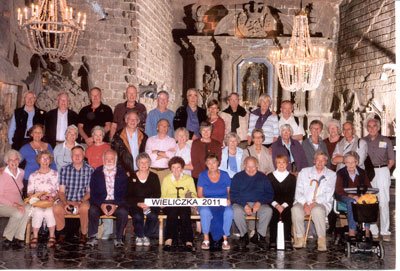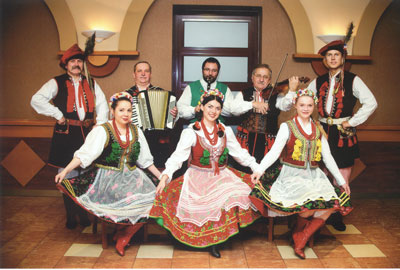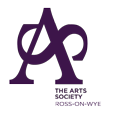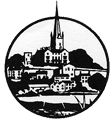KRAKOW - A POLISH(ed) PERFORMANCE
 The Society's September 2011 trip to the delightful city of Krakow was regarded as a great success
by the party of 35 members, comprising spouses and friends who took part. Our very great thanks
are due to Frances Clarke, who worked brilliantly with Norman Allen Group Travel to make it an
experience which will be long remembered.
The Society's September 2011 trip to the delightful city of Krakow was regarded as a great success
by the party of 35 members, comprising spouses and friends who took part. Our very great thanks
are due to Frances Clarke, who worked brilliantly with Norman Allen Group Travel to make it an
experience which will be long remembered.
We set off by coach on the Tuesday late afternoon for the Holiday Inn at Bristol Airport so that a 3.30 a.m. start on the Wednesday was possible – if not exactly pleasurable. By late morning we had reached the modern and comfortable Andels Hotel in Krakow, very well situated just outside the walls of the old city. Lunch and a first look at the vast market square and its surroundings were the order of the day for many, followed, for some, by a catch-up on the beauty sleep before dinner in the hotel.
The following day we were formed into two groups – the A Team and those of a more leisurely disposition – for various tours over the next few days, principally with Krystyna and Tom, our main Polish guides. Their excellent, idiomatic English and prolific knowledge of Polish history brought to life the good and the bad of a country that has been invaded and subjugated for long periods of its existence but has yet survived through its religion and its indomitable spirit.
The morning tours of the old city that day and the next covered various churches, with a great many chapels, tombs, other ornate memorials and one magnificent bell tower; the Castle overlooking the Vistula river, with its fine architecture and interesting collection of art, furniture and tapestries; the impressive interior of the Cathedral; the grand architecture of central university building; the imposing Cloth Hall; and the Florianska Gate and Barbican, reminders of Krakow's continual need to defend itself.
About half of our party went, on the Wednesday afternoon, for a sobering visit to Auschwitz and to Birkenau, about thirty miles west of Krakow. The sombre former army camp buildings at Auschwitz with their simple pictorial displays and emotive displays of prisoners' abandoned possessions which told the horrific story of 1940-45 will not ever be forgotten by us. Agnes, another first rate young guide for this visit, relayed the facts and figures in a remarkably restrained way, which somehow accentuated the enormity of the suffering.
Saturday morning brought an interesting coach tour to Pieskowa Castle, an impressive building set on a limestone cliff in a wooded valley some thirty-five miles north west of Krakow. Here is housed a fine, if somewhat eclectic, collection of European art and artefacts covering some 600 years; and a large (for Eastern Europe) but not very distinguished group of English paintings. Lunch in the castle's round tower restaurant was good – once we had braved the somewhat daunting waitresses.
Our last full day, Sunday, was a busy one: a morning tour of the Jewish Quarter outside the old city and, across the river, the Podgórze Ghetto area of 1941-43; and an afternoon tour of the former Wieliczka salt mine a few miles to the east. The Jewish Quarter had existed since the 13thC. and had numbered some 60-80,000 residents at its peak. From 1940 onwards, the deportations of the population to rural areas, to work camps and then to the Ghetto, and onwards to extermination in Auschwitz and elsewhere virtually eliminated the Krakow Jews. Today there are few and the Quarter is somewhat shabby and faded but there are a few elegant buildings and a handful of synagogues. We were shown round one synagogue, many of us, I suspect, vastly increasing our learning of the Jewish faith and its ceremonies.
 It was something of a relief to get to lunch at the salt mine and back to the present day. Once a
major revenue contributor to the Polish kings - in the days when salt was worth its weight in gold - it
ceased operating commercially in 1996 after over 700 years of production when world prices and
internal flooding made it unprofitable, with still a huge deposit unworked. Now it is a major tourist
attraction with about 1,200,000 visitors a year. Led by Agnes and yet another excellent young guide,
Magdalena, we went down to about 350 feet underground and along some 3 kilometres of passages,
mining scenes and equipment, caverns and small lakes to finish in the astonishing "cathedral", a
massive chamber embellished over many years by a small number of miners working for an hour of
their own time at the end of an eight-hour shift. There is an altar and small chapels, a crucifix, a
depiction of The Last Supper, and other statues – including one of Karol Jósef Wojtyla (Pope John
Paul, a local boy who made it big!) – all carved out of the very pure rock salt. A somewhat
claustrophobic lift brought us back to the surface in less than 30 seconds and we were soon back at
the hotel. That evening we all dined together at Restauracja Szara in the Kazimierz (Jewish) Quarter,
where we were entertained by a very good traditional folk dance group.
It was something of a relief to get to lunch at the salt mine and back to the present day. Once a
major revenue contributor to the Polish kings - in the days when salt was worth its weight in gold - it
ceased operating commercially in 1996 after over 700 years of production when world prices and
internal flooding made it unprofitable, with still a huge deposit unworked. Now it is a major tourist
attraction with about 1,200,000 visitors a year. Led by Agnes and yet another excellent young guide,
Magdalena, we went down to about 350 feet underground and along some 3 kilometres of passages,
mining scenes and equipment, caverns and small lakes to finish in the astonishing "cathedral", a
massive chamber embellished over many years by a small number of miners working for an hour of
their own time at the end of an eight-hour shift. There is an altar and small chapels, a crucifix, a
depiction of The Last Supper, and other statues – including one of Karol Jósef Wojtyla (Pope John
Paul, a local boy who made it big!) – all carved out of the very pure rock salt. A somewhat
claustrophobic lift brought us back to the surface in less than 30 seconds and we were soon back at
the hotel. That evening we all dined together at Restauracja Szara in the Kazimierz (Jewish) Quarter,
where we were entertained by a very good traditional folk dance group.
The journey back home on Monday, 19th September began at a sensible hour and, after a snack lunch at the airport, easyJet saw us back to the UK via Liverpool (as planned), whence we had a surprisingly easy coach ride back to Ross.
Looking back on the holiday what were the highlights? No travel delays to speak of. A friendly hotel that coped well with a not always switched-on clientele. Excellent local guides. Plenty of decorative and fine arts. Chilling but instructive sorties to Auschwitz and the Ghetto. A unique salt mine experience. An appreciation of the Polish people, their troubled history and how far they have come in the 20 or so years since the Russians made their excuses and left. An elegant, well-preserved old city surrounded by cordon sanitaire of trees and with a truly magnificent market square, just right for sitting in a pavement café sipping a glass of something and contemplating the world. Adequate free time to explore alone or in small groups and to sample Polish food specialities. The chance to attend an intimate Chopin piano recital in an authentic setting – a bit like drinking Guinness in Dublin – followed by a leisurely meal in a first class restaurant. And, to crown it all, a friendly party of like- minded people, ably kept in control by Frances.
Philip Blunden

